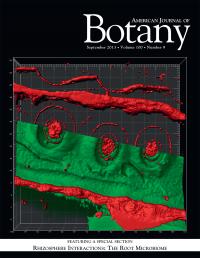
This is the cover of the American Journal of Botany September issue featuring the Rhizosphere Interactions special section. We often ignore what we cannot see, and yet organisms below the soil's surface play a vital role in plant functions and ecosystem well-being. These microbes can influence a plant's genetic structure, its health, and its interactions with other plants. A new series of articles in a Special Section in the American Journal of Botany on Rhizosphere Interactions: The Root Microbiome explores how root microbiomes influence plants across multiple scales—from cellular, bacterial, and whole plant levels to community and ecosystem levels.
Plants are teeming with microbial organisms; not only are they in plant cells, but they are also found in between the cells (intercellular spaces) and in a small layer of soil surrounding plant roots. This area of soil, the rhizosphere, is an especially important zone of activity as it contains microbes that are intricately involved in the molecular, genetic, and ecological components of a plant, and it also influences plant community composition and soil health. The importance of this "unseen majority" led Marnie Rout (University of North Texas Health Science Center) and Darlene Southworth (Southern Oregon University) to gather together a series of works highlighting some of the significant advances that have been made in the last decade in understanding the integrative and far-reaching impacts plant root microbiomes have not only on the organisms themselves, but globally as well.
"Until recently," Rout commented, "the microbiome had been easy to ignore in plant science because soil was considered a 'black box' for so long. But microbial research approaches and molecular techniques are illuminating this unknown—essentially, shining light on the microbiome."
By bringing together works by a diverse set of authors in this special section, Rout and Southworth's intentions are to illustrate the wide spectrum of impacts that microbiomes have on plant performance, and they emphasize that these interactions transcend several scales, from genes to ecosystems.
"Microbiomes play a significant role in the health of their hosts, and microbiome community composition can inform us about the spectrum of healthy-to-diseased host state," said Rout.
Indeed, the papers in this section demonstrate that the microbiome is metabolically diverse and communicates through the rhizosphere, which enables the microbiome to serve as a genomic reservoir for plants and other microbes. The papers also highlight the complex communication exchange that occurs between plants and their microbiomes. 
This is a mass of border cell-root cap mucilage covering a cotton root tip, 30 seconds after immersion into water.
For example, a paper in the special section by Gilberto Curlango-Rivera and associates found that the cell layer that is sloughed off by the roots of certain cotton cultivars and released into the rhizosphere may function as a defense mechanism, serving as a layer of immunity to the plant, similar to that of white blood cells in animals.
"Understanding how the microbiome can regulate plant performance could have enormous implications for many of the world's most pressing problems, such as utilizing marginal lands and fragile ecosystems to meet the food demands of a growing global population, minimizing losses of land and biodiversity due to plant invasions, or mitigating impacts of climate change on plant communities," states Rout.
For example, another paper in this special section, by Drora Kaplan and associates suggests that harvesting growth-promoting bacteria from plants found in harsh or dry climates, such as deserts, could help with crop production in currently stressed regions or in areas likely to be affected by global climate changes.
Rout and Southworth emphasize in the introduction that in order to better understand the intricate and complex impacts microbes have on many levels, from molecular to global, it is critical to understand that the plant microbiome is an integrated genome of the plant, and that it has profound influences on plant genetics, function, ecology, and communities. Interactions between plants and their microbial communities are dynamic—plants can manipulate the microbiome to their advantage (such as defense), and microbiomes can influence which plants survive in certain habitats (such as facilitating invasive species).
"It is my goal for readers to recognize that the plant does not stop at the roots," summarizes Rout. "I think the sustainability of microbes as residents on the planet should inspire everyone to reach a deeper understanding of microbiome influence on the part of the world that we can readily perceive."
Source : rhund@botany.org
 Print Article
Print Article Mail to a Friend
Mail to a Friend
